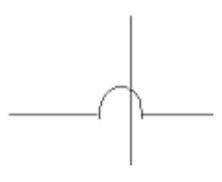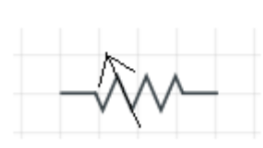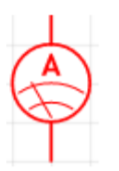
Draw the electrical symbols for the following components and state its uses:
A. Wire crossing
B. Rheostat
C. Ammeter
Answer
570.9k+ views
Hint: There are various electrical components that are used in the circuit diagrams. These are denoted by symbols on a paper and are often marked with their properties next to them. Each electrical component does a specific work.
Complete step-by-step solution:
There are various electrical symbols, which are used in circuit diagrams. These are denoted by symbols on a paper and are often marked with their properties next to them. Each electrical component does a specific work.
These are used to represent the circuit on a paper and often used to refer back.
The symbol of wire crossing is denoted as below, it is used to avoid the connection between two or more wires .i.e. it is used to jump a wire. This is useful when there are two or more wires, which are concentrated in the same region, but they are not connected to each other. Here, one wire crosses above or below the other wire, so that the connection is uninterrupted.

A rheostat, also called as variable resistance is denoted as below, it is used to the change .i.e. increase or decrease the resistance in the circuit. This is handy when it comes to certain experiments, where we need variable resistances or to understand how resistance affects other components of the circuit like current and voltage for example.

An ammeter is a device used to measure the current in the circuit and is denoted as below. An ammeter has minimum resistance to allow current to flow through it, this is because it is always connected in series with the circuit.

Note: An electronic symbol is used to denote various components like the wire, battery, resistor, transistor, and many more. Circuit symbols are used in circuit diagrams showing how a circuit is connected together. The actual layout of the components is usually quite different from the circuit diagram. These are standardized and accepted internationally. The main use of these is to simplify the circuit when drawn on a paper. It is much easier to denote the symbols than writing the words and also reduces language barriers.
Complete step-by-step solution:
There are various electrical symbols, which are used in circuit diagrams. These are denoted by symbols on a paper and are often marked with their properties next to them. Each electrical component does a specific work.
These are used to represent the circuit on a paper and often used to refer back.
The symbol of wire crossing is denoted as below, it is used to avoid the connection between two or more wires .i.e. it is used to jump a wire. This is useful when there are two or more wires, which are concentrated in the same region, but they are not connected to each other. Here, one wire crosses above or below the other wire, so that the connection is uninterrupted.

A rheostat, also called as variable resistance is denoted as below, it is used to the change .i.e. increase or decrease the resistance in the circuit. This is handy when it comes to certain experiments, where we need variable resistances or to understand how resistance affects other components of the circuit like current and voltage for example.

An ammeter is a device used to measure the current in the circuit and is denoted as below. An ammeter has minimum resistance to allow current to flow through it, this is because it is always connected in series with the circuit.

Note: An electronic symbol is used to denote various components like the wire, battery, resistor, transistor, and many more. Circuit symbols are used in circuit diagrams showing how a circuit is connected together. The actual layout of the components is usually quite different from the circuit diagram. These are standardized and accepted internationally. The main use of these is to simplify the circuit when drawn on a paper. It is much easier to denote the symbols than writing the words and also reduces language barriers.
Recently Updated Pages
Basicity of sulphurous acid and sulphuric acid are

Who is the Indian to beat the computers in Mathematical Wizardry?

Where is Himalayan Mountaineering Institute Located?

Which Country is Called "The Land of Festivals"?

Who is the Tennis Player Known as 'King of Clay'?

Who Wrote James Bond? Novel vs. Video Game Facts

Trending doubts
What are the major means of transport Explain each class 12 social science CBSE

What is quantum energy class 12 physics CBSE

Which are the Top 10 Largest Countries of the World?

What is splicing class 12 biology CBSE

Why are dblock elements called Transition elements class 12 chemistry CBSE

What is a secondary cell class 12 chemistry CBSE




